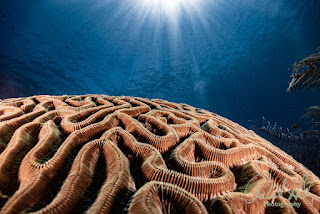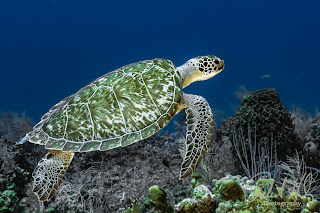Mastering AI Masking for Underwater Photography: Selective Adjustments Made Easy
One of the most revolutionary changes in Adobe Lightroom over the past few years has been the introduction of AI-powered masking tools. For underwater photographers, this is a total game-changer. Whether you're shooting wide-angle reef scenes or macro critters, AI masking allows for precise, selective edits without the tedious brushwork we previously relied on.
AI masking gives us control over specific areas of our images with just a few clicks. The results? Cleaner compositions, more vibrant subjects, and a more polished final image that truly reflects the beauty we observed beneath the waves. In this guide, I’ll walk you through using Lightroom’s AI-driven masking tools to elevate your underwater shots with five specific, real-world examples. I’ll also include helpful keyboard shortcuts and step-by-step instructions so you can dive right in. And yes, I’ll describe example images you can look for in your own archive-plus show you some mock-ups to help visualize each concept.
1. Select Subject: Isolating a Nudibranch from the
Background
Use Case: You want your nudibranch to pop off the frame
while subduing the surrounding reef.
Steps:
- Press "M"
to open the Masking panel.
- Click "Select
Subject." Lightroom’s AI will automatically detect and mask the
nudibranch.
- Increase
Texture (+15 to +30) and Clarity (+10 to +25) to highlight
delicate details.
- Bump
up Vibrance (+10 to +25) to make the colors pop without
over-saturating.
- Optional:
Add Sharpening (+20 to +40) to enhance edge definition.
Why It Works: Nudibranchs are naturally colorful, but
underwater lighting dulls their vibrance. This workflow brings them back to
life without affecting distracting background textures.
Keyboard Shortcuts:
- M =
Open Masking Panel
- Shift
+ W = Select Subject
Sample Image Tip: Use this on a photo in which the nudibranch is clearly separated in color or focus from the reef. The background should be soft and non-competing.
2. Select Background: Enhancing Blue Water Behind a
Turtle
Use Case: Your turtle looks excellent, but the surrounding water
feels bland or hazy.
Steps:
- Press M
to open the Masking panel.
- Click "Select
Subject" to mask the turtle.
- Click "Invert"
to select the background instead.
- Adjust:
- Blacks
(-10 to -25)
- Dehaze
(+10 to +30)
- Saturation
(+5 to +20)
- Reduce
Noise (-10 to -20) to soften the background grain.
Why It Works: In open water shots, haze, and light
scatter often wash out the blues. This AI mask lets you restore color without
affecting your subject.
Keyboard Shortcuts:
- M =
Open Masking Panel
- Shift
+ W = Select Subject
- Ctrl +
' = Invert Mask
Sample Image Tip: Choose a mid-water turtle shot with
enough separation between the subject and background. The background should have
gradation or backscatter that can benefit from clarity/dehaze tweaks.
3. Select Sky: Correcting Backscatter in the Water Column
Use Case: You have a reefscape with a bright upper water
column full of tiny particles (backscatter) or haze.
Steps:
- Press M
to open the Masking panel.
- Click "Select
Sky". Lightroom will often recognize the water column as
"sky."
- Adjust:
- Highlights
(-20 to -40)
- Whites
(-10 to -30)
- Texture
(-15 to -30)
- Clarity
(-10 to -20)
- Use the Spot Removal Tool (Q) for large backscatter spots.
Why It Works: The top of the frame often holds
distracting elements. AI masks let you tone it down in seconds instead of
painting manually.
Keyboard Shortcuts:
- M =
Open Masking Panel
- Shift
+ S = Select Sky
- Q =
Spot Removal Tool
Sample Image Tip: Look for a reef shot with a visible
surface layer, soft backscatter, or sunlight streaks you want to tone down.
4. People Masking: Adjusting Skin Tones on Divers
Use Case: A diver interacts with marine life, but their
skin looks cold or green due to depth and color loss.
Steps:
- Press
M to open the Masking panel.
- Click
"Select People." Lightroom will detect faces and limbs.
- Choose
areas like Face Skin and Body Skin.
- Adjust:
- Temp
(+10 to +25) to warm up
- Tint
(+5 to +15) for pink tones
- Exposure
(+0.2 to +0.5) to lighten shadows
- Contrast
(+10 to +20) for pop
Why It Works: Divers often look unnatural due to the
lack of red light underwater. This targeted mask lets you fix only the human
subject.
Keyboard Shortcuts:
- M =
Open Masking Panel
- Shift
+ P = Select People
Sample Image Tip: Look for shots with visible skin
and face detail, especially against coral or wrecks, where tone correction will stand out.
5. Select Object: Highlighting a Seahorse or Small
Subject
Use Case: You captured a tiny subject that Lightroom doesn’t
recognize as a "subject," but you still want a smart mask.
Steps:
- Press
M to open the Masking panel.
- Click
"Select Object."
- Use
the brush or rectangle to highlight the seahorse.
- Lightroom
will generate a smart mask.
- Enhance
with:
- Texture
(+15 to +30)
- Sharpness
(+20 to +40)
- Exposure
(+0.2 to +0.5)
Why It Works: When subject detection fails, the Select Object tool performs precise masking with AI intelligence.
Keyboard Shortcuts:
- M =
Open Masking Panel
- Shift
+ O = Select Object
Sample Image Tip: Choose macro shots with isolated
subjects - frogfish, gobies, and pipefish with neutral or blurred backgrounds.
Bonus Tip: Combine Masks for More Precision
Use Intersect Mask With... to limit effects to a
refined region:
- Example:
Select Subject (turtle) + Intersect with Radial Gradient to light only the
turtle's face.
Steps:
- Right-click
the mask > "Intersect With Mask..."
- Choose
a new masking tool like Linear Gradient
Wrap-Up: Work Smarter, Not Harder
AI masking tools in Lightroom are not just time-savers; they are creative instruments that provide underwater photographers with control we never had before. These features enable us to refine details, address challenges specific to underwater shooting, and ensure our images reflect what we observed through the mask.
So the next time you're back from a dive and your memory
card is full, don’t dread the editing process. Fire up Lightroom, tap into
those AI tools, and let the software do the heavy lifting. You focus on telling
the story beneath the surface.
Do you have questions or want a walkthrough for your own image? Send me a message or join one of my upcoming Lightroom workshops. Let’s make your underwater photos shine!
- 💡 Read more Lightroom tips at RobertHerb.blogspot.com.
- 💡 Join my upcoming online training program – Learn to enhance your underwater shots with Adobe Lightroom! Sign up for a FREE "Before & After" Gallery.
- 💡 Share your processed photos on social media using #RobertHerbPhotography.
- 💡 Have questions? Email me at bob@robertherb.com.
Written by Robert Herb – Empowering underwater photographers to capture and enhance the beauty of our oceans.
Stay tuned for more in-depth insights into underwater photography. Let’s dive deeper into the art and craft of capturing the marine world! If you have any comments or suggestions, I’d love to hear them.
Get ready for an exciting underwater photography adventure! For more details on my upcoming online training course, check out my "Training" page at RobertHerb.com or email me at bob@robertherb.com.
Sincerely,
Bob Herb
|
|





Comments
Post a Comment
Please let me know your comments.